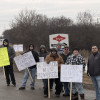During World War I, the government’s labor board, while recognizing the rights of workers to strike, convinced employers and employees to halt the practice of striking until the war ended. But when the war was over, strikes became frequent and hostility between labor unions and employers ran high.
Employers used tactics to stop strikes and break unions, with their goal to end worker power altogether. With yellow-dog contracts, company “unions” and court injunctions, they were successful for a time quashing collective worker power.
A long-term goal of business, and one advocated by the Chamber of Commerce, was to ban unions and have open shops. An open shop is a term used to describe any business that doesn’t recognize unions and doesn’t allow its employees to join one. Unions had grown during the war when shipbuilding and railroads were nationalized.
But as soon as the war ended and those industries were again privatized, the open shop concept grew rapidly through yellow-dog contracts—a pledge workers had to take promising they weren’t a current union member and wouldn’t join a union during employment.
In 1922, The Boilermaker Journal reported on an article from a steel-industry publication that taught managers how to create an open shop, instructing it was never safe to hire a “considerable sprinkling of union men” because they were likely to try to organize other workers.
Of course, employers would rather not deal with a union: but during this period, many workers were also fine in an open shop, largely because of the barrage of anti-union propaganda in the press. The government and media often portrayed union workers as violent or communist. In the two years Warren G. Harding was president, he did a lot of damage to unions. And his successor, Calvin Coolidge, continued to hobble unions.
Because some people did want unions, employers tried another workaround by creating their own company “unions.” They mimicked unions using bylaws and charters, but dues were paid to the company. These “unions” were used to control workers, wages and stamp out dissent. Some of these in-house unions benefited workers with pensions and the ability to buy stock, but those were not in the majority. These company “unions” were mostly bluster and promise and did nothing for workers.
Today, like in the past, employers will do just about anything they can to quell union power and solidarity before it can gain a foothold. And like in the past, it’s collective action that pressures employers to treat their workers with fairness, as happened in the nationwide strike of railroad shopmen in 1922, one of the most important actions in Boilermaker history. Find out about the 1922 shopmen’s strike in the next issue of The Boilermaker Reporter.






